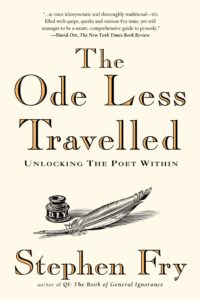Stephen Fry on Form, Part 3
 As I mentioned previously, I’m working through Stephen Fry’s The Ode Less Travelled very slowly to absorb as much wisdom as I can about writing poetry. This week’s post covers Chapter 3, Section 3, on the ballad.
As I mentioned previously, I’m working through Stephen Fry’s The Ode Less Travelled very slowly to absorb as much wisdom as I can about writing poetry. This week’s post covers Chapter 3, Section 3, on the ballad.
The ballad is one of those formats that you may not be able to name, but once you hear a couple of stanzas, you’ll pretty much recognize it. As it turns out, it’s also sometimes called “common meter“, and is also the reason why you can sing many of Emily Dickinson’s poems to the tune of the Gilligan’s Island theme song. The definition in terms of poetry terminology is alternating iambic tetrameter with trimeter in quatrains that cross-rhyme. In plain English, that’s 8/6/8/6, with a rhyme scheme of abab. (But you can also do a “long measure,” which would make it 8/8 (or 9)/8/8 (or 9), and you can also make the rhyme abcb. So it’s variable.)
One of the primary things about ballads is that they’re often folksy and often tell a story. Because of the simple meter and rhyming, they’re easy to remember. And it’s not hard to add another stanza onto an extant ballad by continuing the pattern.
My favorite part of this section was Fry talking about murder ballads (also the name of a great Nick Cave and the Bad Seeds album), wherein it’s a story about a murder, often told by the murderer. I think this is where my jam intersects with ballads.
Plus, then you can sing the murder ballad to the tune of the Gilligan’s Island theme song.
Next up is heroic verse!

Comments